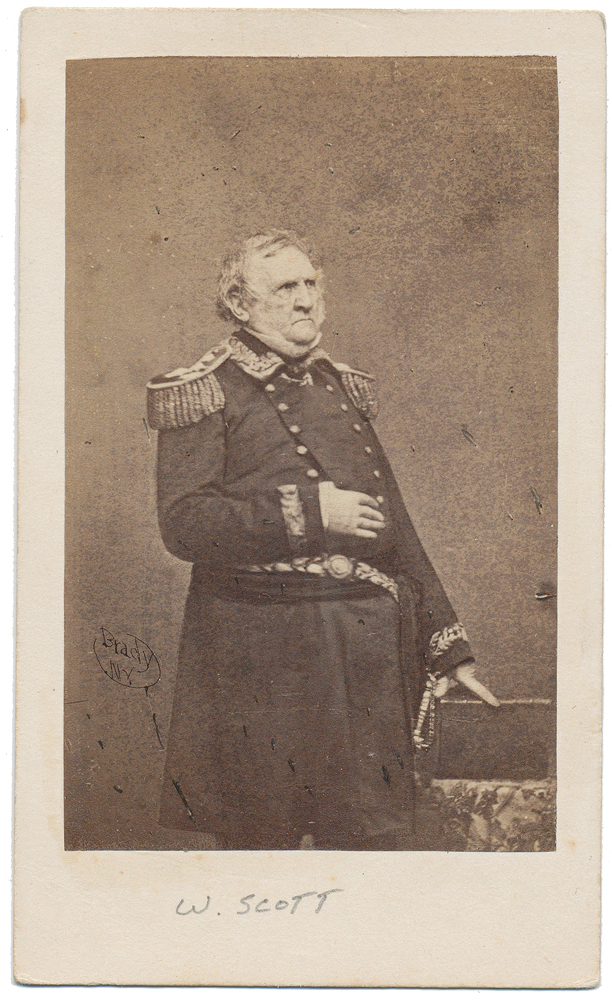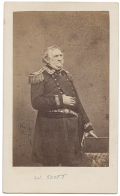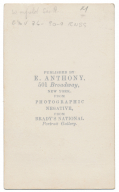site search
online catalog
CDV OF GENERAL WINFIELD SCOTT

$100.00 SOLD
Quantity Available: None
Item Code: 1139-154
Three-quarter standing studio view of Scott in dress uniform. He wears a double-breasted frock with dress epaulettes. He wears a very ornate sword belt and the hilt of the sword is just visible from his far side. Image is clear and has good detail. Photographers backmark, E. Anthony, New York from a Brady negative.
Winfield Scott (June 13, 1786 – May 29, 1866) was an American military commander and political candidate. He served as a general in the United States Army from 1814 to 1861, taking part in the War of 1812, the Mexican–American War, the early stages of the American Civil War. Scott was the Whig Party's presidential nominee in the 1852 election, but was defeated by Democrat Franklin Pierce. He was known as Old Fuss and Feathers for his insistence on proper military etiquette, as well as the Grand Old Man of the Army for his many years of service.
Scott was born near Petersburg, Virginia, in 1786. In the War of 1812, Scott served on the Canadian front, taking part in the Battle of Queenston Heights and the Battle of Fort George, and was promoted to brigadier general in early 1814. He served with distinction in the Battle of Chippawa, but was badly wounded in the subsequent Battle of Lundy's Lane. During the 1830s, Scott negotiated an end to the Black Hawk War, took part in the Second Seminole War and the Creek War of 1836.
In 1841, Scott became the Commanding General of the United States Army. After the outbreak of the Mexican–American War in 1846, Scott was relegated to an administrative role, but in 1847 he led a campaign against the Mexican capital of Mexico City. After capturing the port city of Veracruz, he defeated Mexican General Antonio López de Santa Anna's armies at the Battles of Cerro Gordo, Contreras, and Churubusco. He then captured Mexico City, after which he maintained order in the Mexican capital and indirectly helped envoy Nicholas Trist negotiate the Treaty of Guadalupe Hidalgo, which brought an end to the war.
Scott unsuccessfully sought the Whig presidential nomination three times, in 1840, 1844, and 1848, before winning it in 1852. The Whigs were badly divided over the Compromise of 1850, and Pierce won a decisive victory over his former commander. Nonetheless, Scott remained popular among the public, and in 1855 he received a brevet promotion to the rank of lieutenant general, becoming the first U.S. Army officer to hold that rank since George Washington. Despite being a Virginia native, Scott stayed loyal to the Union and served as an important adviser to President Abraham Lincoln during the opening stages of the Civil War. He developed a strategy known as the Anaconda Plan, but retired in late 1861 after Lincoln increasingly relied on General George B. McClellan for military advice and leadership. In retirement, he lived in West Point, New York.
Scott died at West Point on May 29, 1866, two weeks before his 80th birthday. He is buried at the West Point Cemetery. [jet] [ph:L]
~~~~~~~~~~~~~~~~~~~~~~~~~~~~~~~~~~~
THIS ITEM, AS WITH ALL OTHER ITEMS AVAILABLE ON OUR WEB SITE,
MAY BE PURCHASED THROUGH OUR LAYAWAY PROGRAM.
CLICK HERE FOR OUR POLICIES AND TERMS.
THANK YOU!
Inquire About CDV OF GENERAL WINFIELD SCOTT
For inquiries, please email us at [email protected]
Most Popular
Historical Firearms Stolen From The National Civil War Museum In Harrisburg, Pa »
Theft From Gravesite Of Gen. John Reynolds »
Selection Of Unframed Prints By Don Troiani »
Fine Condition Brass Infantry Bugle Insignia »
British Imported, Confederate Used Bayonet »
Scarce New Model 1865 Sharps Still In Percussion Near Factory New »
featured item
EXQUISITELY BEAUTIFUL LARGE 1862 DATED PORTRAIT OF AN UNKNOWN UNION LIEUTENANT COLONEL
This fantastic painting is oil on canvas and meas. approx. 35.00 x 39.00 inches framed. The subject is an unknown Union lieutenant colonel from the Philadelphia area. He wears a dark blue double-breasted frock coat with gold buttons and a white… (L15593). Learn More »
site search
Upcoming Events
May 16 - 18: N-SSA Spring Nationals, Fort Shenandoah, Winchester, VA Learn More »




